
Clematis is a genus of about 380 species within the buttercup family, Ranunculaceae. Their garden hybrids and cultivars have been popular among gardeners, beginning with Clematis 'Jackmanii', a garden staple since 1862; more cultivars are being produced constantly. They are mainly of Chinese and Japanese origin.

Cercis canadensis, the eastern redbud, is a large deciduous shrub or small tree, native to eastern North America from southern Michigan south to central Mexico, west to New Mexico. Species thrive as far west as California and as far north as southern Ontario. It is the state tree of Oklahoma. The prevalence of the so-called "Columbus strain" has seen the residents of Columbus, Wisconsin, embrace the plant in their city's identity. Known as the "Redbud City," the town hosts "Redbud Day" annually the Saturday before Mother's Day, organizing a variety of themed events to recognize the tree.

Pelargonium is a genus of flowering plants that includes about 280 species of perennials, succulents, and shrubs, commonly called geraniums, pelargoniums, or storksbills. Geranium is also the botanical name and common name of a separate genus of related plants, also known as cranesbills. Both genera belong to the family Geraniaceae. Carl Linnaeus originally included all the species in one genus, Geranium, and they were later separated into two genera by Charles Louis L'Héritier de Brutelle in 1789.

Anemonoides nemorosa, the wood anemone, is an early-spring flowering plant in the buttercup family Ranunculaceae, native to Europe. Other common names include windflower, European thimbleweed, and smell fox, an allusion to the musky smell of the leaves. It is a perennial herbaceous plant growing 5–15 cm (2–6 in) tall.

Lathyrus latifolius, the perennial peavine, perennial pea, broad-leaved everlasting-pea, or just everlasting pea, is a robust, sprawling herbaceous perennial flowering plant in the pea family Fabaceae. It is native to Europe but is present on other continents, such as North America and Australia, where it is most often seen along roadsides.
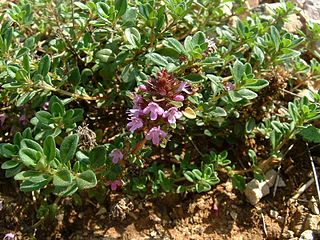
Thymus serpyllum, known by the common names of Breckland thyme, Breckland wild thyme, wild thyme, creeping thyme, or elfin thyme, is a species of flowering plant in the mint family Lamiaceae, native to most of Europe and North Africa. It is a low, usually prostrate subshrub growing to 2 cm (1 in) tall with creeping stems up to 10 cm (4 in) long. The oval evergreen leaves are 3–8 mm long. The strongly scented flowers are either lilac, pink-purple, magenta, or a rare white, all 4–6 mm long and produced in clusters. The hardy plant tolerates some pedestrian traffic and produces odors ranging from heavily herbal to lightly lemon, depending on the variety.

The sweet pea, Lathyrus odoratus, is a flowering plant in the genus Lathyrus in the family Fabaceae (legumes), native to Sicily, southern Italy and the Aegean Islands.

Ribes sanguineum, the flowering currant, redflower currant, red-flowering currant, or red currant is a North American species of flowering plant in the family Grossulariaceae, native to the western United States and Canada.
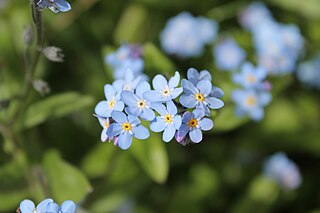
Myosotis sylvatica, the wood forget-me-not or woodland forget-me-not, is a species of flowering plant in the family Boraginaceae, native to Europe. This spring-flowering plant and its cultivars, typically with blue flowers, are the familiar forget-me-nots of gardens.

Rosa pimpinellifolia, the burnet rose, is a species of rose native to western, central and southern Europe and northwest Africa.

Tropaeolum majus, the garden nasturtium, nasturtium, Indian cress or monk's cress, is a species of flowering plant in the family Tropaeolaceae, originating in the Andes from Bolivia north to Colombia. An easily-grown annual or short-lived perennial with disc-shaped leaves and brilliant yellow, orange or red flowers, it is of cultivated, probably hybrid origin. It is not closely related to the genus Nasturtium.
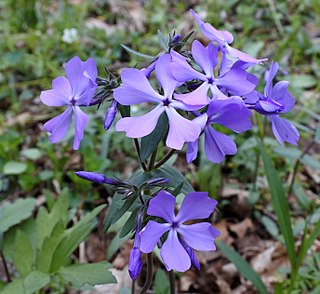
Phlox divaricata, the wild blue phlox, woodland phlox, or wild sweet william, is a species of flowering plant in the family Polemoniaceae, native to forests and fields in eastern North America.
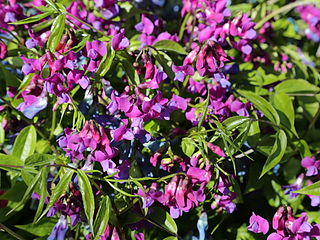
Lathyrus vernus, the spring vetchling, spring pea, or spring vetch, is a species of flowering herbaceous perennial plant in the genus Lathyrus, native to forests of Europe and Siberia. It forms a dense clump of pointed leaves with purple flowers in spring, shading to a greenish-blue with age.

Clematis montana, the mountain clematis, also Himalayan clematis or anemone clematis, is a flowering plant in the buttercup family Ranunculaceae. A vigorous deciduous climber, in late spring it is covered with a mass of small blooms for a period of about four weeks. The odorous flowers are white or pink, four-petalled, with prominent yellow anthers. It is native to mountain areas of Asia from Afghanistan to Taiwan.
Raymond John Evison is a nurseryman, clematis breeder, lecturer, author and photographer. Born in 1944 he started his horticultural career at the age of 15 in Shropshire and moved to the island of Guernsey to set up The Guernsey Clematis Nursery in 1984.

Clematis armandii is a flowering climbing plant of the genus Clematis. Like many members of that genus, it is prized by gardeners for its showy flowers. It is native to much of China and northern Burma. The plant is a woody perennial. It attracts bees, butterflies, and hummingbirds.

Philodendron erubescens, the blushing philodendron or red-leaf philodendron, is a species of flowering plant in the family Araceae, native to Colombia. It is a robust evergreen climber growing to 3–6 m (10–20 ft), with red stems and heart-shaped leaves up to 40 cm (16 in) in length. The flowers are deep red, fragrant spathes up to 15 cm (6 in) long, in summer and autumn. The specific epithet erubescens means "blushing".

Rosa 'Queen Elizabeth' is a pink Grandiflora rose cultivar, bred by rose grower, Dr. Walter Lammerts in the United States in 1954. The rose variety is very popular worldwide and has won numerous awards, including "World's Favorite Rose", (1979).

Clematis heracleifolia, the tube clematis, is a species of flowering plant in the buttercup family Ranunculaceae, native to central and northern China. Unlike most other members of the genus Clematis, it has a scrambling rather than a climbing habit.
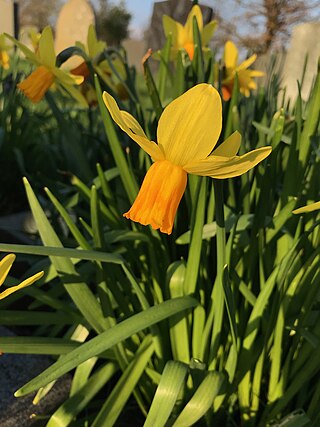
Narcissus 'Jetfire' is a cultivar of dwarf Narcissus, which was introduced in 1966. It is one of many cultivars produced by American daffodil breeder Grant E. Mitsch. 'Jetfire' is a popular early flowering ornamental plant utilized in gardens, where it can be planted into borders, flowerpots, and naturalized in lawns. The cultivar has received multiple awards, including the Award of Garden Merit from the Royal Horticultural Society.



















